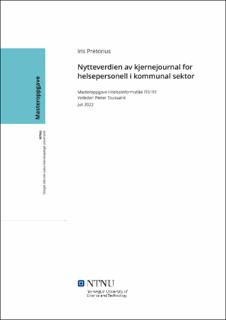| dc.contributor.advisor | Toussaint, Pieter | |
| dc.contributor.author | Pretorius, Iris | |
| dc.date.accessioned | 2023-02-18T18:19:20Z | |
| dc.date.available | 2023-02-18T18:19:20Z | |
| dc.date.issued | 2022 | |
| dc.identifier | no.ntnu:inspera:107356529:37848943 | |
| dc.identifier.uri | https://hdl.handle.net/11250/3052152 | |
| dc.description.abstract | Kjernejournal er den første digitale nasjonale samhandlingsløsningen for deling av pasientenes helseopplysninger på tvers av virksomheter og nivåer i helsevesenet. Kjernejournal er et helseregister hvor det er samlet viktig opplysninger om pasienten, og erstatter ikke pasientjournaler, men kommer i tillegg til dem. Innføring av kjernejournal skal bidra til at man når målet om at nødvendige helseopplysninger skal følge pasienten gjennom hele pasientforløpet, uavhengig av behandlingsted. Løsningen har siden 2017 vært tatt i bruk på alle sykehus, legevakter og hos de fleste fastlegekontorene, men ikke før 2020 ble det mulig for sykehjem og hjemmetjenester i kommunene, å ta i bruk kjernejournal. Informasjonen som er tilgjengelig i kjernejournal fører til at helsepersonellet ikke lenger er avhengig av å motta epikrise eller pleie- og omsorgsmeldinger (PLO-meldinger) for å kunne gjøre seg kjent med pasienten før pasientansvaret overføres. Videre kan ansatte i sykehjem og hjemmetjenester bidra med å registrere viktige opplysninger om pasienten, slik at disse opplysningene blir tilgjengelig for annet helsepersonell i helsetjenesten. Dette er spesielt viktig siden sykehjem og hjemmetjenester ofte kjenner pasientene godt og over tid.
Problemstillingen for studien er,
Hvordan opplever helsepersonell i pleie- og omsorgsektoren nytteverdien til Kjernejournal?
For å besvare problemstillingen utarbeidet jeg følgende forskningsspørsmål:
1. Hvordan påvirkes pasientbehandlingen ved innføring av kjernejournal?
2. Vil kjernejournal påvirke samhandling mellom helsepersonell, og mellom helsepersonell og pasient?
3. Hvordan oppleves informasjonskvaliteten i kjernejournal?
Det er blitt brukt en kvalitativ tilnærming i studien, hvor åtte ansatte i sykehjem og hjemmetjeneste i fem kommunene er blitt intervjuet.
Studien avdekket at samtlige informanter anser informasjonen i kjernejournal som verdifull i arbeidet, og alle har opplevd situasjoner hvor informasjonen funnet i kjernejournal har gitt bedre kvalitet på pasientbehandlingen. Sammen med covid-19 relaterte prøvesvar og vaksinestatus, fremheves legemiddellisten av samtlige sluttbrukerne som den mest nyttige funksjonen i kjernejournal. Informasjonen er enklere tilgjengelig enn tidligere, da informantene i større grad måtte ringe rundt for å innhente opplysninger. Men kjernejournal oppleves også som en ufullstendig løsning som må kompletteres med andre informasjonskilder. Det er imidlertid en forventing om at nytteverdien vil øke når flere informasjonselementer blir lagt til i kjernejournal. | |
| dc.description.abstract | The Norwegian Summary Care Record (SCR) is the first digital national collaboration solution for sharing patients' health information across businesses and levels in the health service. The Norwegian SCR is a health register where important information about the patient has been collected, and does not replace patient records, but is in addition to them. The introduction of the SCR shall contribute to reaching the goal of ensuring that necessary health information is followed throughout the patient journey, regardless of the place of treatment. Since 2017, the solution has been used in all hospitals, emergency departments and most GP surgeries, but only from 2020 is it possible for nursing homes and home care services in the municipalities to use the SCR. The information available in the SCR means that healthcare personnel no longer rely on receiving discharge summaries or electronic messages (PLO messages) in order to familiarize themselves with the patient before patient responsibility is transferred. Furthermore, employees in nursing homes and home care services can help to register important information about the patient, so that this information is available to other health personnel in the health service. This is especially important since nursing homes and home care services often know patients well and over a period of time.
The research question is:
How do healthcare personnel in the nursing and care sector experience the benefits of the Summary Care Record?
To answer the problem, I have prepared the following research questions:
1. How is patient care affected by the introduction of the Summary Care Record?
2. Will the Summary Care Record affect interaction between healthcare personnel, and between healthcare personnel and patients?
3. How is the quality of information experienced in the Summary Care Record?
A qualitative approach has been used in the study, where eight employees in nursing homes and home care services in five municipalities have been interviewed.
The study revealed that all informants consider the information in the SCR to be valuable in their work, and all have experienced situations where the information found in the SCR has improved the quality of patient care. Along with COVID-19 related test results and vaccine status, the medication list is highlighted by all end users as the most useful feature in the SCR. The information is more readily available than before, as previously informants had to often call around to obtain such information. However, it is also perceived as an incomplete solution that must be supplemented with other sources of information. However, there is an expectation. It can become more effective when more elements of information are added to the SCR. | |
| dc.language | nob | |
| dc.publisher | NTNU | |
| dc.title | Nytteverdien av kjernejournal for helsepersonell i kommunal sektor | |
| dc.type | Master thesis | |
